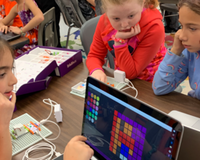When children encounter roadblocks in their daily lives, problem-solving skills become essential. Rather than becoming frustrated when confronted with a problem — such as dealing with peer pressure, a difficult exam, or a lost toy — problem-solving skills allow kids to manage their emotions, think creatively, and discover thoughtful solutions.
Unfortunately, kids who aren’t taught to problem-solve at an early age face challenges well into adolescence — and even into adulthood. In fact, research shows that children who don’t possess problem-solving skills face an increased risk of depression and are more likely to act impulsively as they grow older.
Problem-solving is also identified by the World Economic Forum as one of the top skills necessary to thrive in today’s workforce. Kendra Werner, Sphero’s Education Program Manager, tells us, “Problem-solving exceeds finding a solution to a problem. It encompasses key 21st-century skills: collaboration with peers, creative use of technologies, critical thinking, and clear communication of solutions.”
But, what is the best age to start teaching children problem-solving skills? And, how can you go about implementing these life skills into the classroom? Here at Sphero, we’ve teamed up with Kendra to provide this comprehensive guide answering all your questions on teaching problem-solving.
When To Start Problem-Solving Lessons
When it comes to teaching kids problem-solving skills, it’s best to start as early as possible. Whether you’re a parent or teacher, you can begin incorporating basic problem-solving lessons as early as preschool.
“When children assume problem-solving skills early on, they are empowered to solve not only their own problems, but the challenges of their schools, communities, and the world,” Kendra explains.
Problem-solving is a foundational skill for kids to learn, allowing other skills — such as creativity and innovation — to flourish. Additionally, teaching problem-solving skills to children early on helps them tackle both academic challenges and personal issues, which prepares them to become capable adults.
Teach Problem-Solving Skills With These 3 Activities for Kids
To help you teach problem-solving skills to young learners, Kendra has detailed three fun and engaging activities to try out below:
1. Twenty Questions

This popular activity encompasses problem-solving in disguise! One person thinks of a person, place, or object. The other participants then ask twenty “yes or no'' questions about the item. After asking twenty questions, the participants must guess what the item is. This activity challenges children to practice gathering and evaluating data and then using that data to come up with an idea.
2. Scavenger Hunt

Setting up a scavenger hunt provides a fun and easy opportunity to integrate problem-solving skills into the classroom. To begin, set aside items for students to search for, and print out clues for them to find and follow. Then, divide students into small groups, challenge them to solve problems in order to get the next clue, and have them track their findings on paper. This will push students to collaborate and incorporate peer feedback into their problem-solving process.
3. Brainstorming

Brainstorming activities are some of the easiest ways to promote problem-solving skills, as they can be integrated across all subjects. No matter whether you’re discussing historical events, current events, or fictional subject matter, have your students brainstorm solutions relevant to what you are currently teaching. In these lists, they can imagine ways historical figures or characters might have done things differently to produce better results. This type of brainstorming pushes children to think about multiple scenarios or solutions to a problem.
Helpful Tips for Teaching Kids Problem-Solving Skills
Educators play a key role in helping young children develop the problem-solving skills they use in their everyday lives. While the pressure of getting it right might sound intimidating — especially for those unfamiliar with teaching problem-solving skills — these tips will help you gain the confidence you need to set children up for success:
Encourage and Normalize Failure
No matter what problem-solving activity kids are participating in, encouraging and normalizing failure is key to their success. Failure allows children to learn how to deal with disappointment and manage stress during a frustrating situation.
Additionally, failure gives kids room to innovate. Kendra explains, “Failure is a key component of problem-solving and is what spurs innovation. Give children the space to experiment, take risks, and implement different strategies to tackle a problem, even if not all strategies lead to a solution.”
Let Children Lead
When children encounter problems, it’s important for educators to be a guide, but to ultimately allow the child to solve the issue independently. “When a problem arises, demonstrate that you are there to support your child or student in the problem-solving process, but not there to solve the problems for them. Ask open-ended questions and pose ideas as needed, but encourage children to solve problems on their own,” Kendra says.
Integrate Design Thinking
When teaching problem-solving skills, it’s beneficial to use the concept of design thinking as a framework. Design thinking is the process of questioning a problem and its assumptions, brainstorming an answer, and prototyping and testing solutions.

Kendra tells us, “An iterative design and development process can help guide the problem-solving process and provide children with the opportunity to solve problems in new and different ways. Encourage students to integrate aspects of investigation, creation, iteration, and reflection as they problem-solve.”
Start Teaching Problem-Solving Today
When it comes to 21st-century skills, problem-solving is undoubtedly one of the most important. If children aren’t taught these fundamental skills at a young age, they could face challenges in their personal, academic, and professional lives in the future.
Fortunately, teaching proper problem-solving skills is easy when you know where to focus your efforts. From implementing problem-solving activities into your curriculum to understanding your role in the process, you can lean on this guide to help inform your problem-solving lessons.
Want to make your problem-solving activities even more fun and engaging? With Sphero, kids can learn valuable problem-solving skills through play. Shop Sphero’s programmable robots and STEM kits today!










